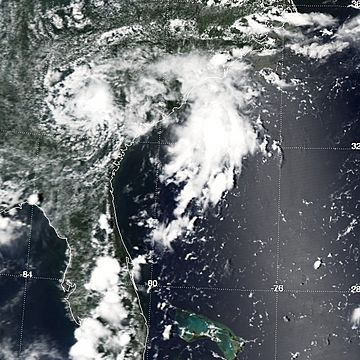Tropical Depression Seven (2003) facts for kids
| Tropical depression (SSHWS/NWS) | |

Tropical Depression Seven
|
|
| Formed | July 25, 2003 |
|---|---|
| Dissipated | July 27, 2003 |
| Highest winds | 1-minute sustained: 35 mph (55 km/h) |
| Lowest pressure | 1016 mbar (hPa); 30 inHg |
| Fatalities | None reported |
| Damage | Minimal |
| Areas affected | Florida, Southeast United States |
| Part of the 2003 Atlantic hurricane season | |
Tropical Depression Seven was a weak tropical depression that formed near the northeast Florida coast. It was the seventh tropical cyclone of the 2003 Atlantic hurricane season. The depression formed on July 25 from the same tropical wave that created another weather system. It was a small and disorganized depression, and it never became a tropical storm, which is stronger than a tropical depression. The depression moved onto land at St. Catherines Island, Georgia, and it quickly weakened. Because the storm was weak, the effects were limited to heavy rain in Florida, Georgia, South Carolina and North Carolina.
Contents
Storm history
A tropical wave, which had also created Tropical Depression Six, combined itself with an upper-level low pressure area to create an area of deep convection near Hispaniola on July 23, 2003. A mid- to lower-level circulation started to form inside the storm as it moved mostly in a north-northwest direction. According to surface and satellite observations, it is thought that the system became Tropical Depression Seven at 1200 UTC on July 25 about 60 miles (95 km) east of Daytona Beach, Florida. The system was caught in an environment characterized by high surface pressures.
At first, the depression moved west-northwest at about 13 mph (20 km/h), and most of the convection from the storm was separated from the center. However, the cloud pattern became organized, and was made up of a number of curved banding features. The storm continued to move northwestward for its whole life, from the steering currents of a subtropical ridge and an approaching mid-level trough.
Moving through an area of cool water temperatures, as well as unfavorable upper-level winds, the depression was not able to get winds greater than 35 mph (55 km/h), and as a result did not gain tropical storm status. Before landfall, the highest winds were measured to exist in a small area northeast of the center of circulation, where a well-defined group of clouds persisted. Early on July 26, it moved onto land on St. Catherines Island, Georgia, and after slowly weakening over land, it died out on July 27.
Impact
The depression was never predicted to become tropical storm status. Because of this, no tropical storm warnings or watches were issued. However, flood watches were issued for part of Georgia and South Carolina. At Georgetown County, South Carolina, officials watched the storm closely.
The depression dropped light to moderate rain from Florida to the coast of North Carolina. The highest rain was 5.17 inches (131 mm) in Savannah, Georgia. Other rainfall totals of 2 to 3 in (50 to 75 mm) were common. There were no damages or casualties because of this depression.
Related pages
Images for kids
-
Damage from Hurricane Fabian on Bermuda



